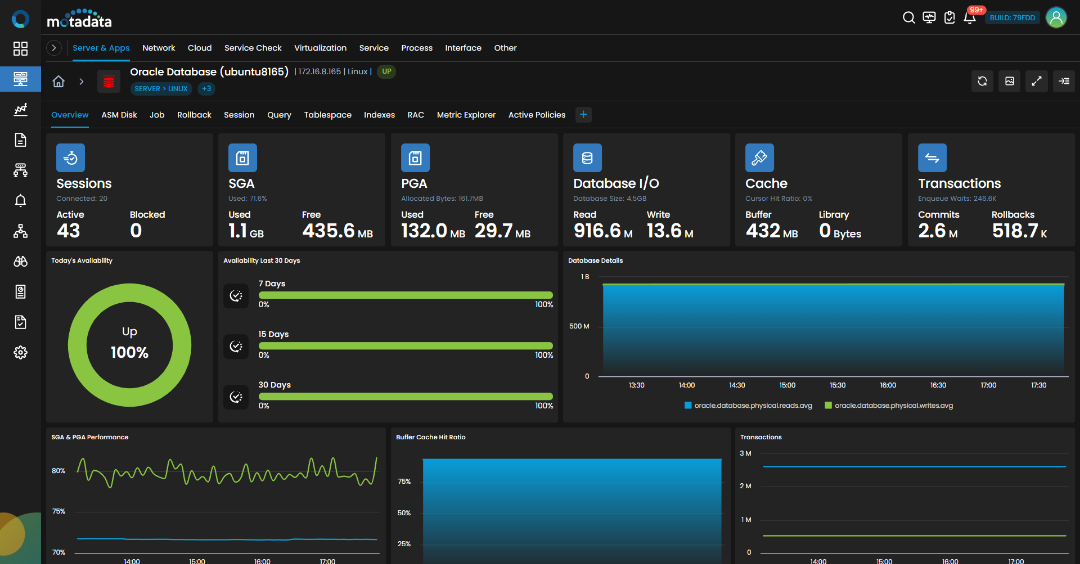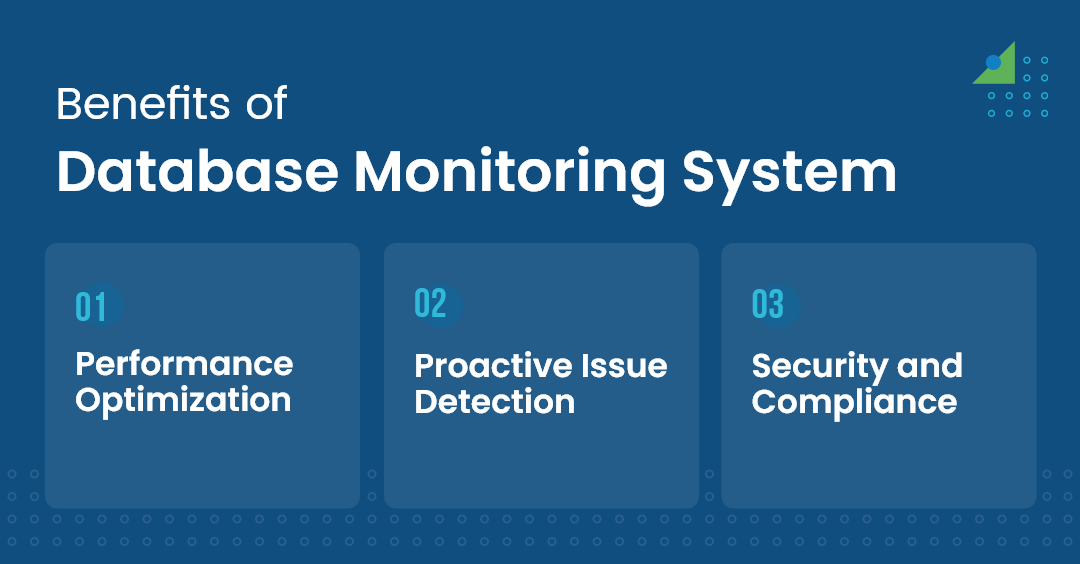Generally, your IT team goes directly to the database when a user asks a question that cannot be answered. A database has the answer to everything, and that’s why a properly running database is integral to keeping your IT operations sound.
Maintaining a healthy IT environment relies heavily on well-maintained databases. By monitoring and running diagnostics on these systems, you can promptly identify and resolve any deviations or problems, emphasizing the significance of database monitoring in IT operations.
Here’s what you need to know about database monitoring and its importance.
What is Database Monitoring?
Database monitoring refers to observing and tracking a database system’s performance, availability, and health. It involves continuously monitoring and analyzing various aspects of a database to ensure its optimal functionality and identify and resolve any issues or potential problems.
Database monitoring facilitates a lot of tasks; here are some of them:
- Identifying performance bottlenecks and optimizing query performance
- Detecting and troubleshooting database issues promptly
- Ensuring database availability and minimizing downtime
- Finding out the reason behind poor system performance
- Monitoring and enhancing database security
- Tracking database usage patterns for resource allocation optimization
- Monitoring database server health, including CPU, memory, and disk usage
Why is Database Monitoring Important?
Effective database monitoring is critical in driving business success as it directly impacts the end-user experience, customer retention, and financial performance. By thoroughly evaluating user and application activity, monitoring provides a comprehensive understanding of the database, empowering organizations to make informed decisions. It enables proactive identification of issues, ensuring a seamless user experience and minimizing potential revenue loss.
Check out below a few benefits of database monitoring that signify its importance.
Benefits of Database Monitoring System:
Performance Optimization: Database monitoring enables organizations to identify and address performance bottlenecks, optimizing query response times, resource utilization, and system health.
Proactive Issue Detection: By continuously monitoring key parameters like disk space, CPU load, and memory consumption, database monitoring helps detect and resolve potential issues before they escalate, ensuring the smooth operation of the database system.
Security and Compliance: Database monitoring enhances security by monitoring unauthorized access attempts, suspicious activities, and data breaches. It also helps organizations meet regulatory compliance requirements by providing auditing capabilities and ensuring data integrity.
How to Monitor the Database?
There are many ways you can monitor your databases. Some examples include:
- Logging into MySQL via SSH/MySQL Workbench/etc., then viewing logs for each table individually. This method requires that you have access to an instance of MySQL running on another server. You could use this method if you were using Amazon RDS. If you don’t want to pay for AWS services, running MySQL instances yourself is unnecessary; connect to them remotely through SSH.
- Using tools like Percona XtraBackup will back up all tables simultaneously. While it doesn’t provide real-time information, it does allow you to see what happened when a problem occurred.
- Performing regular full backups with MySQL dump, then restoring from these backups. This allows you to restore individual tables without creating new ones manually. However, this won’t tell you how long things took to complete.
- Running queries against the data itself. The most common way to do this is by directly querying the INFORMATION_SCHEMA views. These views contain metadata such as column names, types, indexes, etc.
Experience the power of seamless database monitoring
Take control of your data with Motadata’s comprehensive database monitoring solution. Gain real-time insights, enhance performance, and ensure the security of your valuable information.
Database Monitoring Metrics
It is important to strategize the practice of monitoring the Database. Considering the criticalness and dependencies, it is essential to monitor the correct metrics that help an enterprise grow and help resolve problems.
Under each category, there are a few types of database metrics one should consider monitoring. Here are a few Database monitoring metrics the organizations should have in their regular practices.
Infrastructure: When it comes to the organization’s infrastructure, many metrics come into the radar to be monitored.
- CPU usage
- Storage utilization
- Network bandwidth utilization and usage
- Traffic health
Availability: It is essential always to have database availability to ensure smooth performance. It saves customer complaints as outrages can be discovered before failures.
- Using protocols such as Ping or Telnet to access the database nodes.
- Accessing the database ports and endpoints
- Discovering the failed events for master nodes
Throughput: To produce a normal performance baseline, it is crucial to measure throughputs. There are different types of metrics based on the type of the Database. The basic standard metrics are given below.
- Number of active database connections and queries
- Average time to compile the commands
- Average time to finish a read query
- Number of successful transactions
- Number of received and sent commands
- Wait time for database endpoints and ports
Performance: It is essential to monitor the overall performance of the application and Database. Monitoring the performance makes it easy to detect the bottlenecks and problem-causing elements. Here are a few metrics to measure while monitoring the performance of the Database.
- Number of deadlocks and database lock timeouts
- Tracing the applications
- Virtual disk usage
- Queries that run slower than threshold values
- Dead queries
Scheduled Tasks: There are often repetitive tasks known as jobs. Tasks that utilize time and money and leave the essential jobs unassigned. Microsoft SQL Server or Oracle has built-in job scheduling facilities that perform the jobs per the priorities. Other services need to use third-party schedules. Here are a few metrics to monitor while having third-party schedulers.
- Database backups
- Database maintenance
- Application-specific jobs
Also, read: What is Oracle Database Monitoring?
Security: Database security monitoring must operate with global-level comprehensive security goals. Here are a few minimum metrics organizations can monitor.
- The failed login attempts
- Configuration changes in the Database
- Creation of new users
- Password updations
- Unusual traffic
Logs: Logs are one of the pioneers when it comes to monitoring. Every Database has various kinds of log data containing every event and record in the Database. It is beneficial to have log management because logs have precious and sensitive information within.
- Outputs of the scheduled jobs
- Users and system information
- Database system events
Best Practices for Database Monitoring:
Viewing monitored databases in the context of the entire enterprise rather than isolated silos is essential to get the best out of your database monitoring. Enterprises that adopt platforms like Motadata AIOps as a keystone for their IT operations can leverage better from their database monitoring. Such platforms enable a comprehensive evaluation of data, metrics, performance, and activities within their appropriate context.
Here are some best practices for database monitoring that you should adopt:
- Define clear monitoring goals and relevant metrics.
- Select appropriate monitoring tools aligned with your database technology.
- Establish baselines for normal operating conditions and track deviations.
- Implement effective alerting and notifications for timely issue detection.
- Regularly analyze performance, ensure security, and conduct maintenance tasks.
Overall, it’s safe to say that monitoring database is even more critical in today’s digitally driven world. Enterprises with a robust database monitoring system can ensure a smoother user experience and drive business success.
AIOps powered by Motadata is an AI-Driven IT Operation solution that can help you monitor every event and update occurring in your Database. Book your 30-day free trial now.


